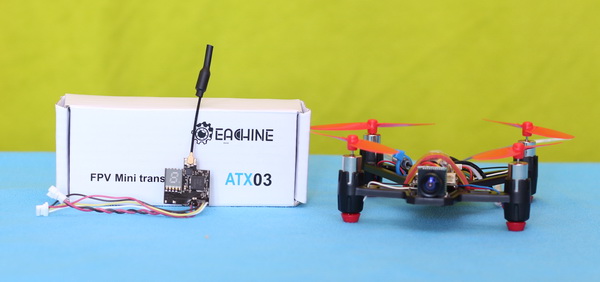Today I will review a super light VTX module for FPV drones. Weighting only 3.5g, the Eachine ATX03 is suitable for small-sized quadcopters.
VTX modules are used to transmit the camera’s video signal wirelessly. The most common frequency for FPV is 5.8Ghz. In order to allow the use of multiple VTXs in the same time (such as during a drone race) the frequency range (5333MHz~5945MHz) is divided into individual channels. Versatile VTX modules like this Eachine ATX03 feature up to 72CH transmission channels.
You can find VTX modules from 25mw up to 10W according to transmission power. While proximity FPV park flying requires less power (25mw is just good for most cases) long-range FPV flights (1 – 10Km) require high TX power. Output power can be fixed or switchable between multiple values like in the case of Eachine ATX03. Note: Always check the local RF regulations when you choose a VTX.

In order to save weight, like in the case of Eachine TX03, the VTX modules are integrated into the camera.
Eachine ATX03 VTX key features
- Adjustable output power (0/25mW/50mW/200mW);
- 3.2-5.5V input voltage (suitable for 1s Li-Po);
- NTSC and PAL video standards;
- Audio line input (10 KΩ impedance);
- 9 bands with total of 72 channels (including Raceband);
- 7 segment status display;
- One button configuration;
- IPEX antenna with connector;
- Very compact (size of 21.43mm * 15.20mm).
Eachine ATX03 VTX review
Disclosure: I received this Eachine ATX03 VTX as part of a product review collaboration with Banggood. Although the product was offered free of charge, all opinions in this review are my own.
The ATX03 VTX comes in a small box together with the instruction manual. Power wires as well as the camera wires are soldered. The 5.8G IPEX antenna is attached to the mainboard through an MHF RF Mini connector.
The VTX module has a size of 20mm x 17mm and weighs about 3.5g, including antenna.
Eachine ATX03 pin out / wire coding
- Red – power out for camera;
- Black – ground / GND;
- Yellow – Video In;
- White – Audio In;
- There is no 5th wire as the user manual says.
On top of the ATX03 5.8G VTX is located a micro push button which allows to configure the VTX. While short pressing the button you can change the channel number (from 1 to 8), by long pressing, you can toggle between bands (A,b E, F, r, U, o, L and H).
Output power can be changed by pressing the same button for over 5 seconds. You can toggle between 0mW, 25mW, 50mW and 200mW.
The actual settings are shown on the 7-segment display. BTW, configurations are stored on a non-volatile memory, so you don’t need to reconfigure the VTX every time you’re powering on.
Eachine ATX03 Review – Test
To test the VTX, I used my RunCam Owl Pus camera, a 3.7V Li-Po battery, and a 7″ FPV monitor.
Unfortunately, Eachine doesn’t include with the ATX03 a 4 to 3-pin adaptor cable. This would allow direct use of the VTX with audio-less cameras without any modification (soldering).
Setting up the Eachine ATX03 VTX is very simple. I like the “one button” approach.
Range is excellent even at 25mW. In my opinion, you don’t need to set higher output power for park flying. Don’t forget that increasing the broadcast power will put more stress to the flight battery.
I didn’t test the audio carrier, but I’ve read from other fellows that is a bit noisy.
Pricing and availability
For those interested in a lightweight and cheap VTX, this ATX03 can be ordered from here. I recommend ordering together with the VTX a “Y” power cable to avoid soldering.